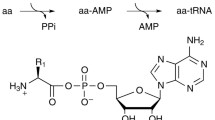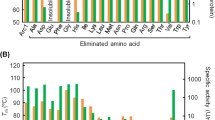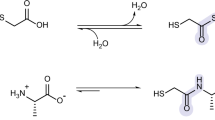Abstract
Post-translational modification of proteins by N-phosphorylation of the basic amino acid residues plays important roles in biological processes. The high-energy P-N bond might have contributed to the evolution of prebiotic chemistry. N-phosphoryl amino acids (PAAs) can serve as interesting small molecular models for the study of P-N bonds in prebiotic chemical evolution. PAAs are capable of simultaneously producing several important biomolecules such as polypeptides and oligonucleotides under mild reaction conditions. In this review, we describe the chemistry of PAAs, discusse their likely prebiotic origins and their reactivity and how they relate to biological P-N bond species. We also depict a possible prebiotic scenario mediated by PAAs in which PAAs may have acted as one of the essential forces driving prebiotic biomolecules to the first protocell.
Similar content being viewed by others
References
Derouiche A, Cousin C, Mijakovic I. Protein phosphorylation from the perspective of systems biology. Curr Opin Biotechnol, 2012, 23: 585–590
Hunter T. Why nature chose phosphate to modify proteins. Phil Trans R Soc B, 2012, 367: 2513–2516
Matthews HR. Protein-kinases and phosphatases that act on histidine, lysine, or arginine residues in eukaryotic proteins: a possible regulator of the mitogen-activated protein-kinase cascade. Pharmacol Ther, 1995, 67: 323–350
Ciesla J, Fraczyk T, Rode W. Phosphorylation of basic amino acid residues in proteins: important but easily missed. Acta Biochim Pol, 2011, 58: 137–148
Zu XL. Wilson and Wilson’s Comprehensive Analytical Chemistry. Amsterdam: Elsevier, 1959
Loroch S, Dickhut C, Zahedi RP, Sickmann A. Phosphoproteomics: more than meets the eye. Electrophoresis, 2013, 34: 1483–1492
Attwood PV, Piggott MJ, Zu XL, Besant PG. Focus on phosphohistidine. Amino Acids, 2007, 32: 145–156
Serpi M, Bibbo R, Rat S, Roberts H, Hughes C, Caterson B, Jose Alcaraz M, Torrent Gibert A, Alaez Verson CR, McGuigan C. Novel phosphoramidate prodrugs of N-acetyl-(D)-glucosamine with antidegenerative activity on bovine and human cartilage explants. J Med Chem, 2012, 55: 4629–4639
Reardon S. United States to approve potent oral drugs for hepatitis C. Nature, 2013, doi: 10.1038/nature.2013.14059
Cheng CM, Liu XH, Li YM, Ma Y, Tan B, Wan R, Zhao YF. N-phosphoryl amino acids and biomolecular origins. Orig Life Evol Biosph, 2004, 34: 455–464
Gao X, Deng H, Tang G, Liu Y, Xu P, Zhao Y. Intermolecular phosphoryl transfer of N-phosphoryl amino acids. European J Org Chem, 2011: 3220–3228
Hess JF, Bourret RB, Simon MI. Histidine phosphorylation and phosphoryl group transfer in bacterial chemotaxis. Nature, 1988, 336: 139–143
Swanson RV, Alex LA, Simon MI. Histidine and aspartate phosphorylation: 2. Component systems and the limits of homolog. Trends BiochemSci, 1994, 19: 485–490
Smith DL, Bruegger BB, Halpern RM, Smith RA. New histone kinases in nuclei of rat tissues. Nature, 1973, 246: 103–104
Besant PG, Attwood PV. Histone H4 histidine phosphorylation: kinases, phosphatases, liver regeneration and cancer. Biochem Soc Trans, 2012, 40: 290–293
Crovello CS, Furie BC, Furie B. Histidine phosphorylation of P-selectin upon stimulation of human platelets: a novel pathway for activation-dependent signal transduction. Cell, 1995, 82: 279–286
Besant PG, Attwood PV, Piggott MJ. Focus on phosphoarginine and phospholysine. Curr Protein Pept Sci, 2009, 10: 536–550
Boyer PD, Deluca M, Ebner KE, Hultquist DE, Peter JB. Identification of phosphohistidine in digests from a probable intermediate of oxidative phosphorylation. J Biol Chem, 1962, 237: PC3306–PC3308
Ek P, Pettersson G, Ek B, Gong F, Li JP, Zetterqvist O. Identification and characterization of a mammalian 14-kDa phosphohistidine phosphatase. Eur J Biochem, 2002, 269: 5016–5023
Munoz-Dorado J, Almaula N, Inouye S, Inouye M. Autophosphorylation of nucleoside diphosphate kinase from Myxococcus xanthus. J Bacteriol, 1993, 175: 1176–1181
Wieland T, Nurnberg B, Ulibarri I, Kaldenbergstasch S, Schultz G, Jakobs KH. Guanine nucleotide-specific phosphate transfer by guanine-nucleotide-binding regulatory protein beta-subunits: characterization of the phosphorylated amino-acid. J Biol Chem, 1993, 268: 18111–18118
Kowluru A, Seavey SE, Rhodes CJ, Metz SA. A novel regulatory mechanism for trimeric GTP-binding proteins in the membrane and secretory granule fractions or human and rodent beta cells. Biochem J, 1996, 313: 97–107
Cuello F, Schulze RA, Heemeyer F, Meyer HE, Lutz S, Jakobs KH, Niroomand F, Wieland T. Activation of heterotrimeric G proteins by a high energy phosphate transfer via nucleoside diphosphate kinase (NDPK) B and Gbeta subunits. Complex formation of NDPK B with Gbeta gamma dimers and phosphorylation of His-266 IN Gbeta. J Biol Chem, 2003, 278: 7220–7226
Maurer A, Wieland T, Meissl F, Niroomand F, Mehringer R, Krieglstein J, Klumpp S. The beta-subunit of G proteins is a substrate of protein histidine phosphatase. Biochem Biophys Res Commun, 2005, 334: 1115–1120
Hippe HJ, Lutz S, Cuello F, Knorr K, Vogt A, Jakobs KH, Wieland T, Niroomand F. Activation of heterotrimeric G proteins by a high energy phosphate transfer via nucleoside diphosphate kinase (NDPK) B and Gbeta subunits. Specific activation of Gsalpha by an NDPK B.Gbetagamma complex in H10 cells. J Biol Chem, 2003, 278: 7227–7233
Wagner PD, Vu ND. Phosphorylation of ATP-citrate lyase by nucleoside diphosphate kinase. J Biol Chem, 1995, 270: 21758–21764
Wagner PD, Steeg PS, Vu ND. Two-component kinase-like activity of nm23 correlates with its motility-suppressing activity. Proc Natl Acad Sci USA, 1997, 94: 9000–9005
Klumpp S, Bechmann G, Maurer A, Selke D, Krieglstein J. ATP-citrate lyase as a substrate of protein histidine phosphatase in vertebrates. Biochem Biophys Res Commun, 2003, 306: 110–115
Krieglstein J, Lehmann M, Maurer A, Gudermann T, Pinkenburg O, Wieland T, Litterscheid S, Klumpp S. Reduced viability of neuronal cells after overexpression of protein histidine phosphatase. Neurochem Int, 2008, 53: 132–136
Srivastava S, Li Z, Ko K, Choudhury P, Albaqumi M, Johnson AK, Yan Y, Backer JM, Unutmaz D, Coetzee WA, Skolnik EY. Histidine phosphorylation of the potassium channel KCa3.1 by nucleoside diphosphate kinase B is required for activation of KCa3.1 and CD4 T cells. Molecular Cell, 2006, 24: 665–675
Srivastava S, Zhdanova O, Di L, Li Z, Albaqumi M, Wulff H, Skolnik EY. Protein histidine phosphatase 1 negatively regulates CD4 T cells by inhibiting the K+ channel KCa3.1. Proc Natl Acad Sci USA, 2008, 105: 14442–14446
Freiman RN, Tjian R. Regulating the regulators: lysine modifications make their mark. Cell, 2003, 112: 11–17
Smith BC, Denu JM. Chemical mechanisms of histone lysine and arginine modifications. Biochimica et Biophysica Acta, 2009, 1789: 45–57
Hofmann FT, Lindemann C, Salia H, Adamitzki P, Karanicolas J, Seebeck FP. A phosphoarginine containing peptide as an artificial SH2 ligand. Chem Commun (Camb), 2011, 47: 10335–10337
Bertran-Vicente J, Serwa RA, Schumann M, Schmieder P, Krause E, Hackenberger CP. Site-specifically phosphorylated lysine peptides. J Am Chem Soc, 2014, 136: 13622–13628
Wakim BT, Aswad GD. Ca2+-calmodulin-dependent phosphorylation of arginine in histone-3 by a nuclear kinase from mouse leukemia-cells. J Biol Chem, 1994, 269: 2722–2727
Fuhrmann J, Schmidt A, Spiess S, Lehner A, Turgay K, Mechtler K, Charpentier E, Clausen T. McsB is a protein arginine kinase that phosphorylates and inhibits the heat-shock regulator CtsR. Science, 2009, 324: 1323–1327
Wilson ME, Consigli RA. Characterization of a protein kinase activity associated with purified capsids of the granulosis virus infecting Plodia interpunctella. Virology, 1985, 143: 516–525
Sikorska M, Whitfield JF. Isolation and purification of a new 105 kDa protein kinase from rat liver nuclei. Biochim Biophys Acta, 1982, 703: 171–179
Levy-Favatier F, Delpech M, Kruh J. Characterization of an arginine-specific protein kinase tightly bound to rat liver DNA. Eur J Biochem, 1987, 166: 617–621
Zetterqvist O, Engstrom L. Isolation of N-e-32P phosphoryl-lysine from rat-liver cell sap after incubation with 32P adenosine triphosphate. BBA, 1967, 141: 523–532
Chen CC, Smith DL, Bruegger BB, Halpern RM, Smith RA. Occurrence and distribution of acid-labile histone phosphates in regenerating rat liver. Biochemistry, 1974, 13: 3785–3789
Chen CC, Bruegger BB, Kern CW, Lin YC, Halpern RM, Smith RA. Phosphorylation of nuclear proteins in rat regenerating liver. Biochemistry, 1977, 16: 4852–4855
Fazekas S, Hutas I, Ovary I, Szekessy-Heymann V. Presence of covalently bound energy-rich phosphates in human tracheal smooth muscle myosin. Acta Physiol Hung, 1987, 70: 385–395
Zaia DAM, Zaia CTBV, De Santana H. Which amino acids should be used in prebiotic chemistry studies? Origins Life Evol B, 2008, 38: 469–488
Miller SL. A production of amino acids under possible primitive earth conditions. Science, 1953, 117: 528–529
Westheimer FH. Why nature chose phosphates. Science, 1987, 235: 1173–1178
Bowler MW, Cliff MJ, Waltho JP, Blackburn GM. Why did nature select phosphate for its dominant roles in biology? New J Chem, 2010, 34: 784–794
Schwartz AW. Phosphorus in prebiotic chemistry. Phil Trans R Soc B, 2006, 361: 1743–1749
Todd AR. Where there’s Life there’s Phosphorus. Tokyo: Japan Sci Soc Press, 1981
Duve DC. Blueprint for a Cell: the nature and origin of life. Burlington, NC: N. Patterson, 1991
Gulick A. Phosphorus as a factor in the origin of life. Am Scientist, 1955, 43: 479–489
Keefe AD, Miller SL. Are polyphosphates or phosphate esters prebiotic reagents? J Mol Evol, 1995, 41: 693–702
Pasek MA. Rethinking early Earth phosphorus geochemistry. Proc Natl Acad Sci USA, 2008, 105: 853–858
Adcock CT, Hausrath EM, Forster PM. Readily available phosphate from minerals in early aqueous environments on Mars. Nature Geosci, 2013, 6: 824–827
Yamagata Y, Watanabe H, Saitoh M, Namba T. Volcanic production of polyphosphates and its relevance to prebiotic evolution. Nature, 1991, 352: 516–519
Krishnamurthy R, Arrhenius G, Eschenmoser A. Formation of glycolaldehyde phosphate from glycolaldehyde in aqueous solution. Orig Life Evol Biosph, 1999, 29: 333–354
Mullen LB, Sutherland JD. Formation of potentially prebiotic amphiphiles by reaction of beta-hydroxy-n-alkylamines with cyclotriphosphate. Angew Chem Int Ed, 2007, 46: 4166–4168
Ni F, Sun S, Huang C, Zhao Y. N-phosphorylation of amino acids by trimetaphosphate in aqueous solution-learning from prebiotic synthesis. Green Chem, 2009, 11: 569–573
Rabinowitz J, Flores J, Kresbach R, Rogers G. Peptide formation in the presence of linear or cyclic polyphosphates. Nature, 1969, 224: 795–796
Ni F, Gao X, Zhao ZX, Huang C, Zhao YF. On the electrophilicity of cyclic acylphosphoramidates (CAPAs) postulated as intermediates. European J Org Chem, 2009: 3026–3035
Gao X, Ni F, Bao J, Liu Y, Zhang Z, Xu P, Zhao Y. Formation of cyclic acylphosphoramidates in mass spectra of N-monoalkyloxyphosphoryl amino acids using electrospray ionization tandem mass spectrometry. J Mass Spectrom, 2010, 45: 779–787
Li YM, Yin YW, Zhao YF. Phosphoryl group participation leads to peptide formation from n-phosphorylamino acids. Int J Pept Protein Res, 1992, 39: 375–381
Ma XB, Zhao YF. Phosphoryl group participation in the reactions of n-phosphoryldipeptide acids. Phosphorus Sulfur Silicon Relat Elem, 1992, 66: 107–114
Li YM, Zhao YF. The bioorganic chemical-reactions of n-phospho-amino acids without side-chain functional-group participated by phosphoryl group. Phosphorus Sulfur Silicon Relat Elem, 1993, 78: 15–21
Xue CB, Yin YW, Zhao YF. Studies on phosphoserine and phosphothreonine derivatives-n-diisopropyloxyphosphoryl-serine and n-diisopropyloxyphosphoryl-threonine in alcoholic media. Tetrahedron Lett, 1988, 29: 1145–1148
Yang HJ, Jian L, Zhao YF. N-S phosphoryl migration in phosphoryl glutathione. Int J Pept Protein Res, 1993, 42: 39–43
Zhou WH, Ju Y, Zhao YF, Wang QG, Luo GA. Simultaneous formation of peptides and nucleotides from N-phosphothreonine. Orig Life Evol Biosph, 1996, 26: 547–560
Zhao YF, Cao PS. Phosphoryl amino-acids-common origin for nucleic-acids and protein. J Biol Phys, 1994, 20: 283–287
Fu H, Li ZL, Zhao YF, Tu GZ. Oligomerization of N,O-bis(trime-thylsilyl)-alpha-amino acids into peptides mediated by o-phenylene phosphorochloridate. J Am Chem Soc, 1999, 121: 291–295
Hou JB, Zhang H, Guo JN, Liu Y, Xu PX, Zhao YF, Blackburn GM. Chirality at phosphorus in pentacoordinate spirophosphoranes: stereochemistry by X-ray structure and spectroscopic analysis. Org Biomol Chem, 2009, 7: 3020–3023
Zeng ZP, Hou JB, Zhang H, Zhao YF. New feature in the chiral bisamino acyl pentacoordinate spirophosphoranes. Scientia Sinica Chimica, 2010, 7: 878–887
Gao X, Liu Y, Xu PX, Cai YM, Zhao YF. Alpha-amino acid behaves differently from beta- or gamma-amino acids as treated by trimetaphosphate. Amino Acids, 2008, 34: 47–53
Chen ZZ, Tan B, Li YM, Zhao YF, Tong YF, Wang JF. Activity difference between alpha-COOH and beta-COOH in N-phosphory-laspartic acids. J Org Chem, 2003, 68: 4052–4058
Chen ZZ, Li YM, Ma J, Tan B, Inagaki S, Zhao YF. Activities of alpha-COOH vs gamma-COOH in N-phosphoryl amino acids: a theoretical study. J Phys Chem A, 2002, 106: 11565–11569
Lightstone FC, Bruice TC. Ground state conformations and entropic and enthalpic factors in the efficiency of intramolecular and enzymatic reactions. 1. Cyclic anhydride formation by substituted glutarates, succinate, and 3,6-endoxo-delta(4)-tetrahydrophthalate monophenyl esters. J Am Chem Soc, 1996, 118: 2595–2605
Xiao X, Zhang Y. Life in extreme environments: approaches to study life-environment co-evolutionary strategies. Sci China Earth Sci, 2014, 57: 869–877
Liu Y. Seryl-histidine dipeptide: an original molecule evolutionary model of modern protease. Scientia Sinica Chimica, 2011, 41: 579–586
Han DX, Wang HY, Ji ZL, Hu AF, Zhao YF. Amino acid homochirality may be linked to the origin of phosphate-based life. J Mol Evol, 2010, 70: 572–582
Han D, Chen W, Han B, Zhao Y. A new theoretical model for the origin of amino acid homochirality. Sci China Ser C-Life Sci, 2007, 50: 580–586
Author information
Authors and Affiliations
Corresponding author
Rights and permissions
About this article
Cite this article
Ni, F., Fu, C., Gao, X. et al. N-phosphoryl amino acid models for P-N bonds in prebiotic chemical evolution. Sci. China Chem. 58, 374–382 (2015). https://doi.org/10.1007/s11426-015-5321-1
Received:
Accepted:
Published:
Issue Date:
DOI: https://doi.org/10.1007/s11426-015-5321-1




